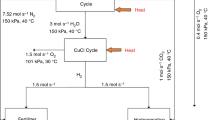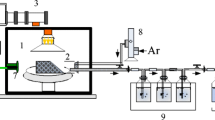Abstract
In Japan, a Waste To Energy (WTE) plant with a strict NOx emission limit value of 50 ppm (O2 12%-dry) has been operated with selective non-catalytic reduction (SNCR). Ammonia or urea is used as a media for SNCR, but urea is safer than ammonia and is easy to use. However, urea has a problem of lower NOx removal efficiency than ammonia. Therefore, a technology to convert urea to ammonia on-site is necessary. In this work, the basic performance of this urea decomposition system, the operation results of SNCR, and the CO2 reduction by SNCR were studied.The urea decomposition system was a catalytic reactor, and when the catalytic temperature was above 250 °C and the space velocity was below 6000 h−1, the conversion to ammonia was almost 100%. The NOx removal ratio of SNCR was 20% at an ammonia equivalence ratio of 0.4 and about 40% at an equivalence ratio of 0.6, a performance level similar to other plant. Furthermore, it was estimated that CO2 emissions were reduced by 3.1% by applying SNCR instead of SCR, and when combined with other CO2 reduction measures of this plant, CO2 emissions were reduced by 16.2%.







Similar content being viewed by others
References
Air Pollution Control Act (Act No. 97 of June 10, 1968)
Furubayashi M, Yasuda N (2010) The effects of easing the self-regulation of nitrogen oxides emitted byMSW incinerators to improve power generation. Mater Cycles Waste Manag Res 21(6):395–403. https://doi.org/10.3985/mcwmr.21.395. (in Japanese)
DIRECTIVE 2010/75/EU OF THE EUROPEAN PARLIAMENT AND OF THE COUNCIL of 24 November 2010 on industrial emissions (integrated pollution prevention and control) (Recast) (Text with EEA relevance), https://eur-lex.europa.eu/legal-content/EN/TXT/PDF/?uri=CELEX:32010L0075&from=EN
Oliver G, Toralf W, Philippe S, Yann L (2010) A new process for NO x reduction in combustion systems for the generation of energy from waste. Waste Manag 30(7):1348–1354. https://doi.org/10.1016/j.wasman.2010.02.024
GB 18485 (2014) Standard for pollution control on the municipal solid waste incineration. China
Yao Y, Wang Q (2021) Low temperature SCR cost evaluation in solid waste incineration power plant. IOP Conf Ser Earth Environ Sci 651(2):1755–1307. https://doi.org/10.1088/1755-1315/651/2/022055
Zhang P, Zhang P, Shao Y, Niu J, Zeng X, Zheng X, Wu C (2022) Effect of low-nitrogen combustion system with flue gas circulation technology on the performance of NOx emission in waste-to-energy power plant. Chem Eng Process. https://doi.org/10.1016/j.cep.2022.108910
Atsushi H, Katsuhisa U, Hiroshi O (2016) Transition of Waste to Energy Technology. In: The 9th international conference on combustion, incineration / pyrolysis, emission and climate change, session I-1, Sep. 20–23, Kyoto, Japan
Hiroki Y, Munechika I (2016) Low NOx combustion by EGR and SNCR in MSW incineration plant. In: The 9th international conference on combustion, incineration / pyrolysis, emission and climate change, session II-6, Sep. 20–23, Kyoto, Japan
Yasuki M (2016) High efficiency waste to energy plant with low exhaust gas emissions: a case of ota incineration plant. In: The 9th international conference on combustion, incineration / pyrolysis, emission and climate change, session I-1, Sep. 20–23, Kyoto, Japan
Xufcong Y, Yanfen L, Xiaoqian M, Jinpeng Z (2022) Effects of air supply optimization on NOx reduction in a structurally modified municipal solid waste incinerator. Appl Thermal Eng. https://doi.org/10.1016/j.applthermaleng.2021.117706
Bosch H, Janssen F (1986) Catalytic reduction of nitrogen oxides: a review on the fundamental and technology. Catal Today 2(4):369–521
Tayyeb JM, Irfan N, Gibbs BM (2007) Control of combustion-generated nitrogen oxides by selective non-catalytic reduction. J Environ Manag 83(3):251–289. https://doi.org/10.1016/j.jenvman.2006.03.006
Kohei Y, Michitaka F, Akihiro U (2016) Low NOx combustion with exhaust gas recirculation and SNCR in stoker type incinerator. In: The 9th international conference on combustion, incineration / pyrolysis, emission and climate change, session I-4, Sep. 20–23, Kyoto, Japan
Anichkov SN, Zykov AM, Tumanovskii AG, Kulish ON, Zaporozhskii KI (2021) Development of SNCR technology and prospects of its application. Therm Eng 68(6):510–515. https://doi.org/10.1134/S004060152106001X
Zhifeng Hu, Enchen J, Xiaoqian Ma (2019) Numerical simulation on operating parameters of SNCR process in a municipal solid waste incinerator. Fuel 245:160–173. https://doi.org/10.1016/j.fuel.2019.02.071
Zihong X, Jian L, Tingting W, Caixia C, Xiaoke Z (2014) CFD simulation of MSW combustion and SNCR in a commercial incinerator. Waste Manage 34(9):1609–1618. https://doi.org/10.1016/j.wasman.2014.04.015
Zengying L, Xiaoqian M (2010) Mathematical modeling of MSW combustion and SNCR in a full-scale municipal incinerator and effects of grate speed and oxygen-enriched atmospheres on operating conditions. Waste Manage 30(12):2520–2529. https://doi.org/10.1016/j.wasman.2010.05.006
Frederik N, Gianluca C, Jorge GB, Simon H, Serge R (2019) Best available techniques (BAT) reference document for waste incineration, industrial emissions directive 2010/75/EU integrated pollution prevention and control. https://eippcb.jrc.ec.europa.eu/sites/default/files/2020-01/JRC118637_WI_Bref_2019_published_0.pdf
Kawachi H, Morihara T, Nishimura K, Sukawa T (2018) Development of NOx reduction technologies for MSW incineration plants. Kubota Techn Rep 51:102–107 ((in Japanese))
Wlodzimierz B, Jan G (2006) A round about route to NOx reduction. Mod Power Syst 26(6):53–54
Wendt JOL, Linak WP, Groff PW, Srivastava RK (2001) Hybrid SNCR-SCR technologies for NOx control: modeling and experiment. AIChE J 47(11):2603–2617. https://doi.org/10.1002/aic.690471123
Guang Hu, Jian Y, Yuanmeng T, Bowen K, Qingcai L, Shan R, Jiangling Li, Ming K (2018) Effect of Ce doping on the resistance of Na over V2O5-WO3/TiO2 SCR catalysts. Mater Res Bull 104:112–118. https://doi.org/10.1016/j.materresbull.2018.04.009
Herrlander B (1990) Recent developments in de-NOx technology. ABB Rev 7:3–8
Qiulin W, Xiaoniu H, Yuheng F, Jianjian Z, Huancong S, Jing J (2021) Interaction mechanism study on simultaneous removal of 1,2-dichlorobenzene and NO over MnOx -CeO2 /TiO2 catalysts at low temperatures. Ind Eng Chem Res 16(13):4820–4830. https://doi.org/10.1021/acs.iecr.0c05862
Hyounduk J, Eunseuk P, Minsu K, Jongsoo J (2017) Pilot-scale evaluation of a novel TiO2 -supported V2 O5 catalyst for DeNOx at low temperatures at a waste incinerator. Waste Manage 61:283–287. https://doi.org/10.1016/j.wasman.2016.11.006
Dong J, Jeswani HK, Nzihou A, Azapagic A (2020) The environmental cost of recovering energy from municipal solid waste. Appl Energy. https://doi.org/10.1016/j.apenergy.2020.114792
Jo VC, Johan DG, Chantal B, Carlo V (2016) NOx reduction in waste incinerators by selective catalytic reduction (SCR) instead of selective non catalytic reduction (SNCR) compared from a life cycle perspective: a case study. J Clean Prod 112:4452–4460. https://doi.org/10.1016/j.jclepro.2015.08.068
Wei Z, David M, Vitali L, Chen J-Y (2009) Development and implementation of numerical simulation for a selective noncatalytic reduction system. Ind Eng Chem Res 48(24):10994–11001. https://doi.org/10.1021/ie9004089
Alzueta MU, Bilbao R, Millera A, Oliva M, Ibanez JC (1998) Interactions between nitric oxide and urea under flow reactor conditions. Energy Fuels 12(5):1001–1007. https://doi.org/10.1021/ef980055a
Alzueta MU, Bilbao R, Millera A, Oliva M, Ibanez JC (2000) Impact of new findings concerning urea thermal decomposition on the modeling of the urea-SNCR process. Energy Fuels 14(2):509–510. https://doi.org/10.1021/ef990187j
Kleemann M, Elsener M, Koebel M, Wokaun A (2000) Hydrolysis of isocyanic acid on SCR catalysts. Ind Eng Chem Res 39(11):4120–4126. https://doi.org/10.1021/ie9906161
Yim SD, Kim SJ, Baik JH, Nam I-S, Mok YS, Lee J-H, Cho BK, Oh SH (2004) Decomposition of urea into NH3 for the SCR process. Ind Eng Chem Res 43(16):4856–4863. https://doi.org/10.1021/ie034052j
Masaaki K, Muneharu F, Hiroki F, Norio M (2015) Selective non-catalytic reduction(SNCR) test with urea decomposing device. Takuma Tech Rev 23(1):72–78 (In Japanese)
Japanese Industrial Standards Committee (JIS) (latest revision for 2020) Methods for determination of ammonia in flue gas (JIS K0099) (in Japanese)
Ministry of the Environment, Japan (2021) Manual for the development of watste to energy facility, https://www.env.go.jp/content/900536142.pdf(in Japanese)
Ministry of the Environment, Japan (2022) Medium- to long-term scenario for net zero greenhouse gas emissions in 2050 in the field of waste and resource recycling (draft), https://www.env.go.jp/council/content/i_03/000048390.pdf(in Japanese)
Furubayashi M, Shigemasa S, Sato T, Miyamoto Y, Yasuda T (2014) The 25th Annual Conference of Japan Society of Material Cycles and Waste Management, 301–302, Hiroshima, Japan, September 2014
Tokyo Electric Power Company Holdings, Incorporated, Web Page. https://www.tepco.co.jp/ep/notice/news/2022/1663624_8910.html
Takaoka M, Takeda N, Yamagata N, Masuda T (2011) Current status of waste to power generation in Japan and resulting reduction of carbon dioxide emissions. J Mater Cycles Waste Manage 13:198–205. https://doi.org/10.1007/s10163-011-0019-8
Acknowledgements
We gratefully acknowledge the work of the Regional Cleaning Union of the city of Ota and three towns and all the parties concerned.
Author information
Authors and Affiliations
Corresponding author
Additional information
Publisher's Note
Springer Nature remains neutral with regard to jurisdictional claims in published maps and institutional affiliations.
Rights and permissions
Springer Nature or its licensor (e.g. a society or other partner) holds exclusive rights to this article under a publishing agreement with the author(s) or other rightsholder(s); author self-archiving of the accepted manuscript version of this article is solely governed by the terms of such publishing agreement and applicable law.
About this article
Cite this article
Ito, M., Tozaki, M. SNCR deNOx process by urea decomposition system and evaluation of CO2 reduction. J Mater Cycles Waste Manag 26, 435–443 (2024). https://doi.org/10.1007/s10163-023-01840-3
Received:
Accepted:
Published:
Issue Date:
DOI: https://doi.org/10.1007/s10163-023-01840-3




